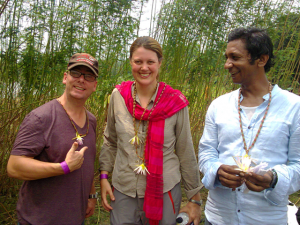Behind the camera with Charlotte Scott
Posted on by Lauren MacCarthy.
Charlotte Scott, Producer / Director at BBC Natural History Unit takes us behind the camera and describes what it’s like to make wildlife films…
I currently work at the BBC Natural History Unit in Bristol and last year I had a phone call saying “We are going to make an exhibition on wildlife filmmaking can you help?” I jumped at the chance.
‘Nature, Camera, Action! The secrets of making incredible wildlife films’ is an exhibition aimed at families and fittingly it opened this summer here in M Shed. Bristol is known as the Hollywood of the UK in terms of wildlife film making with a biannual wildlife film festival – Wildscreen that is the equivalent to Wildlife Oscars centred here. The BBC Natural History Unit, based in Bristol is along with many independent companies responsible for producing millions of pounds worth of natural history programming every year.
Wildlife films made in the UK are sold all over the world, the images transcend cultural differences and are increasingly a reminder to us of what is missing in many of our lives, nature. Now that over 50% of the world is urban based, there is an increasing need to share the wonders of nature, as if people don’t know about it how can they care about nature and feel empowered to try and protect it?
Filming wildlife is never simple, the logistics start with researching the animal or plant including its life-cycle, who the main scientists researching them are, and the best time and place to film them. Then after getting a crew together you often fly to a really remote location with tons and tons of kit, only for the people on the ground to ask as your foot hits the tarmac. “Why are you here now? You should have been here a month ago!”… whether this is true or not.

Charlotte Scott (centre) on location in Bangladesh
After invariably setting up camp in a freezing or boiling location you then get your first joys of nature arriving at your door. The overpowering fishy aroma of thousands of nesting penguins, an army of ants that decide your camp is in their way, or inquisitive monkeys that have their eye on your food.
This all pales into the background when you have that special moment when you first see the animal you are looking for and the cameraman or woman is able to film the behaviour you have all gone to such lengths to capture. Some shoots are not successful the first time or even the second – filming snow leopards being one such challenging case. But the rewards are worth all the ‘suffering’ and hours in hides, up trees, at the bottom of the sea or shut into a tiny hut.
After a few shoots you start build up resilience, your ability to adapt kit and plans when needed, to have patience even when it has totally run out and to know that you might feel you are going slightly mad after 5+ weeks in one location, with not much to show for it. Above all it usually comes together on the very last day of filming however much you plan ahead. The animals after all have their own time table!
Charlotte Scott is a Producer / Director at BBC Natural History Unit. To find out more about coming a wildlife film maker, join us at the Wildlife Film Roadshow on Friday 23 October.
‘Nature, Camera, Action! The secrets of making incredible wildlife films’ is open until Sunday 1 November 2015.